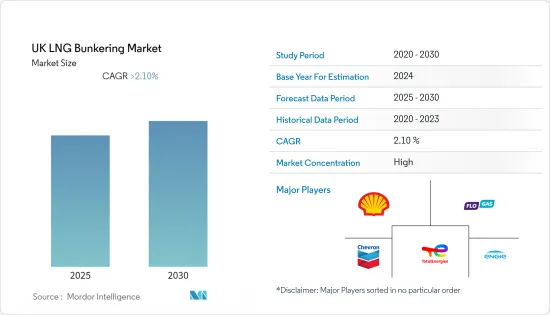Need help finding what you are looking for?
Contact Us
PUBLISHER: Mordor Intelligence | PRODUCT CODE: 1630418

PUBLISHER: Mordor Intelligence | PRODUCT CODE: 1630418
UK LNG Bunkering - Market Share Analysis, Industry Trends & Statistics, Growth Forecasts (2025 - 2030)
PUBLISHED:
PAGES: 90 Pages
DELIVERY TIME: 2-3 business days
SELECT AN OPTION
The UK LNG Bunkering Market is expected to register a CAGR of greater than 2.1% during the forecast period.

The COVID-19 outbreak negatively impacted the market due to regional lockdowns and supply chain disruptions. Currently, the market reached pre-pandemic levels.
Key Highlights
- The bunker fuel supply and availability landscape changed when the IMO's regulation capping the global fuel Sulphur limit at 0.50% was enforced on 1 January 2020, likely driving the LNG bunkering market in the United Kingdom.
- However, the lack of LNG bunkering infrastructure will likely hurt the demand for LNG bunkering activities in the country during the forecast period.
- The reduced natural gas prices began expanding opportunities for LNG bunkering activities in the coming years.
UK LNG Bunkering Market Trends
Ferries and OSV Segment to Dominate the Market
- In the next five years, the LNG-based ferries and OSVs are projected to increase, considering the large number of LNG-fueled ferries and OSVs on order. It is likely to increase the demand for LNG bunkering services in the forecast period.
- The United Kingdom's government's plan to increase the country's global oil and gas production share is expected to boost the market. The United Kingdom Continental Shelf (UKCS) region is expected to become one of the most active offshore regions for maritime transport.
- Indigenous oil and gas production contributed around USD 28.4 billion to the United Kingdom's GDP in 2022. The UK government forecasts that two-thirds of the country's energy mix is expected to come from oil and gas by 2035.
- Additionally, various anticipated oil & gas decommissioning projects scheduled during the forecast period will likely increase the demand for OSVs, which is expected to drive the market.
- Since a major portion of the trade occurs through ships, and with the ship operators operating the LNG-fueled engines, the demand for LNG bunkering fuels is expected to increase in the country during the forecast period.
Growth in Oil & Gas Activities to Drive the Market
- To implement a sustainable and environmentally friendly transport network, the government of the United Kingdom, along with various oil and gas and shipping operators, promoted the use of LNG-powered marine transport. It will likely drive the LNG bunkering market in the oil & gas industry.
- The key factors driving the LNG bunkering market in the oil & gas industry are the increase in LNG demand to reduce carbon footprint in the shipping industry and the demand for natural gas in the country. Furthermore, LNG is a better alternative fuel, and the government is taking initiatives for LNG adaptation.
- The natural gas production in 2021 was about 32.7 billion cubic meters, providing around 16% production share to the region. Natural gas production is expected to rise in the coming years owing to the country's reduced price.
- According to Baker Hughes, the offshore rig count was 13 in March 2023, higher than the offshore rig count of March 2022. Thus indicating the dominancy of offshore oil and gas activities in the country over onshore.
- It calls for demand for ships in oil and gas E&P-related activities, likely to boost the target market over the forecast period.
UK LNG Bunkering Industry Overview
The United Kingdom LNG bunkering market is consolidated. Some of the key players in the market include (in no particular order) Flogas Britain Ltd, Chevron Corporation, Engie SA, TotalEnergies SE, and Shell PLC.
Additional Benefits:
- The market estimate (ME) sheet in Excel format
- 3 months of analyst support
Product Code: 71256
TABLE OF CONTENTS
1 INTRODUCTION
- 1.1 Scope of the Study
- 1.2 Market Definition
- 1.3 Study Assumptions
2 EXECUTIVE SUMMARY
3 RESEARCH METHODOLOGY
4 MARKET OVERVIEW
- 4.1 Introduction
- 4.2 Market Size and Demand Forecast in USD million, till 2028
- 4.3 Recent Trends and Developments
- 4.4 Government Policies and Regulations
- 4.5 Market Dynamics
- 4.5.1 Drivers
- 4.5.2 Restraints
- 4.6 Supply Chain Analysis
- 4.7 PESTLE Analysis
5 MARKET SEGMENTATIONBY END-USER
- 5.1 Tanker Fleet
- 5.2 Container Fleet
- 5.3 Bulk and General Cargo Fleet
- 5.4 Ferries and OSV
- 5.5 Others
6 COMPETITIVE LANDSCAPE
- 6.1 Mergers and Acquisitions, Joint Ventures, Collaborations, and Agreements
- 6.2 Strategies Adopted by Leading Players
- 6.3 Company Profiles
- 6.3.1 Engie SA
- 6.3.2 Chevron corporation
- 6.3.3 TotalEngeries SE
- 6.3.4 Flogas Britain Ltd
- 6.3.5 Shell PLC
7 MARKET OPPORTUNITIES AND FUTURE TRENDS
Have a question?


SELECT AN OPTION
Have a question?


Questions? Please give us a call or visit the contact form.
